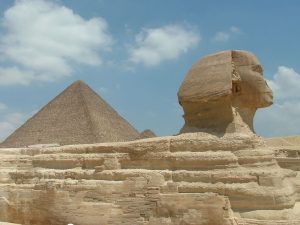Egyptian Culture

Nine most famous Archaeological Egyptian Sites:
(A) Abu Rawash: Abu Rawash is the northernmost site of the Memphite Necropolis. It got its modern-day name from the nearby village Abu Rawash and appears to have been used as a burial site since the time of Aha, at the beginning of the 1st Dynasty
(B) Abusir: Abusir is the Arab name for the Greek Busiris, which in turn is a rendering of the Ancient Egyptian name Per-Usir, which means The House of Osiris. Its Ancient Egyptian name refers to Osiris, the god of the dead and resurrection and it is thus not surprising that Abusir was a part of the Memphite necropolis.
(C) Dashur: It owes its modern-day name to the two nearby villages Dashur and Minisat Dashur. On a clear day, the two pyramids built by Snofru can very clearly be seen. It is the southernmost site of the Memphite necropolis and extends to Abu – Rawash in the north.
(D) Itj- Tawi: After Amenhemhat – I came to power he left Thebes and built a new capital. This capital was named Itj- Tawi meaning “One that seizes two lands”. Though it was never exactly found it is said to be located on the banks of the Fayum Oasis as that’s where every king of the 12th Dynasty chose to build his Funerary Monument.
(E) Giza: The Pyramid of Giza, perhaps one of Egypt’s best-known Egyptian Sites, is a magnificent structure indeed. It is located slightly south of the entrance of the Delta. It is one of the northernmost cemeteries of the Memphite necropolis. The pyramid called the Pyramid of Kheops was one of the Seven Wonders of the World.
(F) Memphis: This is the famous city that divides upper and Lower Egypt. Its original name Mn-nfr, “the beautiful monument” was used to refer to the pyramid in the city Pepi I’s pyramid. However, the reason for why a structure, relatively minor in importance (as compared to structures such as the pyramid of Giza) became the name of a whole city remains shrouded in mystery.
(G) Saqqara: It is located at the entrance of the Nile delta where the river starts dividing into several arms. Its first tombs were probably built on the ridges to the west of the town of Memphis. Its most prominent site that can even be seen from Giza is called Djoser’s step pyramid.
(H) The Valley of Kings: The Valley of the Kings is a desert valley located on the west bank of Thebes, the political and religious capital of the New Kingdom. It was first used as royal necropolis by Thutmosis I, although it was his predecessor, Amenhotep I, who was considered as the patron-god of the valley by the actual builders of the tombs.
(I) Zawyet el Aryan: Zawyet el-Aryan is located to the South of Giza and North of Abusir and Abu Gorab. There are two unfinished pyramids at Zawyet el-Aryan. The oldest one is dated to the 3rd Dynasty and would have been a Step Pyramid had it been completed. The other pyramid was built somewhere during the 4th Dynasty, but it is not known for certain by which king.
This is, of course, an extremely brief compilation of famous Egyptian sites. However, every one of them is not just an amazing sight to see but a veritable treasure when it comes to excavation and finding more archaeological evidence of Egyptian culture.
